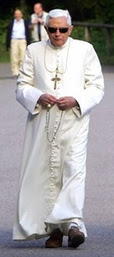Three General Chapters must each affirm any alteration to the Rule, customs or rites of the Canons Regular of the Dormition (and those of their sisters in holy religion, the Dormitionistine Canonesses); and, since all who were in holy religion at the time of the last General Chapter must have gone to their reward ere a new General Chapter may be summoned, it will be unsurprising to learn that the questionable modifications to the Sacred Liturgy otherwise effected throughout the Roman Church have not yet even been discussed by the Dormitionists.
Given the well-known criticisms of those first fruits of the liturgical reform that are the new rites of Holy Week, it seems to this scribe and friend of their Order rather unlikely that any great changes to their Missal will be considered at their upcoming General Chapter (for Canon Serapion, last survivor of those alive at the Chapter of 1931, expired at this year's Paschal Vigil just a few days ago, its very protracted length constituting the Last Rites for him – a circumstance of which I have just been informed, prompting these reflections), especially given the well-known latitude, not to say favour, extended by the present Sovereign Pontiff to the venerable liturgical forms of old.
What venerable, what lengthy rites? Amongst the Dormitionists, the Vigil of Easter has always been maintained as indeed the Vigil of all Vigils: for not only have they kept it always in the evening, having retained the ancient custom of evening Mass, they have retained on this night of nights the primitive custom of the Roman Church, whereby each of the twelve prophecies is read first in Latin, then in Greek, to total twenty-four passages of Holy Writ. (It will be thus evident why Canon Serapion expired. As Dom Odo Casel dropt dead after singing the Exsultet, so to go to God at the Paschal Vigil is to indeed be united ever to the Paschal Mystery.)
However, in other respects the Dormitionist Holy Saturday service is somewhat simpler, for they have something of the Carthusian simplicity about their sober liturgical practices, as is only to be expected of an enclosed contemplative Order, not given to gaudy show. As should be obvious, for instance, their oratories have no font, and therefore there is no blessing thereof: instead, the last of the prophecies concluded, the Litanies of the Saints are begun forthwith. (During these, the celebrant prostrates as if dead, the Litanies prayed by all from memory in a low, procumbent mumble. Once the words Peccatores, te rogamus, audi nos are said, the priest thus addressed arises and retires to the sacristy to change his purple vestments to white for Mass.)
But, far more startlingly to the uninitiated, as with the Carthusians, there is no Easter fire, no reed, no Paschal Candle, nor Exsultet – no gaudy show. Instead, the great length of this Vigil is occupied with “searching the Scriptures”. In this, these retiring Canons in their humility act as their brothers the Carthusians, and as did the lesser churches of Rome, in the ages before the privilege of having their own Paschal candle was extended to them by Pope Zosimus – for, all Easter baptisms being carried out by the Supreme Pontiff at St John Lateran, there and there alone were Candle and Font once blessed.
There are a few unusual practices to remark upon during this beginning of the solemn Paschal liturgy: just as on Good Friday according to their Missal, neither Flectamus genua nor Levate are said, and for utterly the same reason – as is the custom in the Order, the Canons in choir lie prostrate throughout, and so ’twould be superfluous and ridiculous to bid them bend the knee and then arise. Furthermore, what in the older Roman Rite were the eleventh and twelfth prophecies are read in reverse order, so that Nabuchodonosor rex (Dan. iii, 1-24) is read in Latin and Greek before Scripsit Moyses (Deut. xxxi, 22-30) is: in this way, just as after the first eight lessons (four in Latin, four in Greek) there occurs a canticle or Tract (Cantemus Dño), and likewise after the middle eight another (Vinea facta est), so too the last eight conclude with a Tract, Attende cœlum.
Attentive students of symbolism will at once remark upon the wise ordering of these pericopes, gathered into three sets of eight: for eight is the number of the Resurrection, and three that of the prefatory Three Days’ Rest in the Sepulchre, or again of the three ages of the spiritual life, from purgative via illuminative unto unitive, as Christ’s Resurrection grace produces. Again, if the three Tracts be numbered with all the Lessons, we have three times nine, nine being the number of choirs of the Angels, who ever do worship and laud the Trinity, the Three Persons in One God; or, if with each eight lessons the four collects accompanying are enumerated, we have three times twelve, but I digress. (The Summa Triviæ supplies further details on these and related points.)
There remains little else to remark upon, for the Easter Mass that begins as the Litanies end is the same as that otherwise celebrated throughout the Roman Church down to modern times, save for those peculiarities of the Dormitionist Ordo Missæ discussed elsewhere. Of course, on this night there is no Introit – the last cadences of the Litany supply it – nor Creed, nor Offertory, nor Agnus Dei, nor Communion antiphon: for all these are later additions to the venerable solemnities, and (as Baumstarck noted) on days of the greatest solemnity, the most ancient rites are most faithfully preserved. Mindful, too, of the more primitive practice, the Dormitionists alone of all in Western Christendom celebrate no Vespers at all on this holy night (for the short Vespers otherwise inserted into the Mass on Easter Eve are a later invention). Instead, as is their peculiar wont, they proceed at once to Compline.








No comments:
Post a Comment